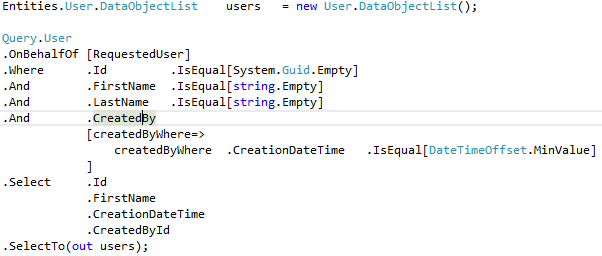So, it’s been awhile since I’ve published a post on this site. Today I found myself answering a stack overflow post with essentially what I had planned on covering for this part of my series on generics in .net. So I figured that I would post the same content here. As a result, this 5th part is being publish out of order and before parts 2-4. Hopefully, it won’t be another year before I get around to posting those parts. So with that said, here is the post. Note that some of the concepts employed in this post will be covered in parts 2-4.
For those who work with multiple generic classes that share the same generic type parameters, the ability to declare a generic namespace would be extremely useful. Unfortunately, .Net (or at least C#) does not support the idea of generic namespaces. So in order to accomplish the same goal, we can use generic classes to fulfill the same goal. Take the following example classes related to a logical entity:
public class BaseDataObject
<
tDataObject,
tDataObjectList,
tBusiness,
tDataAccess
>
where tDataObject : BaseDataObject<tDataObject, tDataObjectList, tBusiness, tDataAccess>
where tDataObjectList : BaseDataObjectList<tDataObject, tDataObjectList, tBusiness, tDataAccess>, new()
where tBusiness : IBaseBusiness<tDataObject, tDataObjectList, tBusiness, tDataAccess>
where tDataAccess : IBaseDataAccess<tDataObject, tDataObjectList, tBusiness, tDataAccess>
{
}
public class BaseDataObjectList
<
tDataObject,
tDataObjectList,
tBusiness,
tDataAccess
>
:
CollectionBase<tDataObject>
where tDataObject : BaseDataObject<tDataObject, tDataObjectList, tBusiness, tDataAccess>
where tDataObjectList : BaseDataObjectList<tDataObject, tDataObjectList, tBusiness, tDataAccess>, new()
where tBusiness : IBaseBusiness<tDataObject, tDataObjectList, tBusiness, tDataAccess>
where tDataAccess : IBaseDataAccess<tDataObject, tDataObjectList, tBusiness, tDataAccess>
{
}
public interface IBaseBusiness
<
tDataObject,
tDataObjectList,
tBusiness,
tDataAccess
>
where tDataObject : BaseDataObject<tDataObject, tDataObjectList, tBusiness, tDataAccess>
where tDataObjectList : BaseDataObjectList<tDataObject, tDataObjectList, tBusiness, tDataAccess>, new()
where tBusiness : IBaseBusiness<tDataObject, tDataObjectList, tBusiness, tDataAccess>
where tDataAccess : IBaseDataAccess<tDataObject, tDataObjectList, tBusiness, tDataAccess>
{
}
public interface IBaseDataAccess
<
tDataObject,
tDataObjectList,
tBusiness,
tDataAccess
>
where tDataObject : BaseDataObject<tDataObject, tDataObjectList, tBusiness, tDataAccess>
where tDataObjectList : BaseDataObjectList<tDataObject, tDataObjectList, tBusiness, tDataAccess>, new()
where tBusiness : IBaseBusiness<tDataObject, tDataObjectList, tBusiness, tDataAccess>
where tDataAccess : IBaseDataAccess<tDataObject, tDataObjectList, tBusiness, tDataAccess>
{
}
We can simplify the signatures of these classes by using a generic namespace (implemented via nested classes):
public
partial class Entity
<
tDataObject,
tDataObjectList,
tBusiness,
tDataAccess
>
where tDataObject : Entity<tDataObject, tDataObjectList, tBusiness, tDataAccess>.BaseDataObject
where tDataObjectList : Entity<tDataObject, tDataObjectList, tBusiness, tDataAccess>.BaseDataObjectList, new()
where tBusiness : Entity<tDataObject, tDataObjectList, tBusiness, tDataAccess>.IBaseBusiness
where tDataAccess : Entity<tDataObject, tDataObjectList, tBusiness, tDataAccess>.IBaseDataAccess
{
public class BaseDataObject {}
public class BaseDataObjectList : CollectionBase<tDataObject> {}
public interface IBaseBusiness {}
public interface IBaseDataAccess {}
}
Then, through the use of partial classes you can separate the classes into separate nested files. I recommend using a Visual Studio extension like NestIn to support nesting the partial class files. This allows the “namespace” class files to also be used to organize the nested class files in a folder like way.
For example:
Entity.cs
public
partial class Entity
<
tDataObject,
tDataObjectList,
tBusiness,
tDataAccess
>
where tDataObject : Entity<tDataObject, tDataObjectList, tBusiness, tDataAccess>.BaseDataObject
where tDataObjectList : Entity<tDataObject, tDataObjectList, tBusiness, tDataAccess>.BaseDataObjectList, new()
where tBusiness : Entity<tDataObject, tDataObjectList, tBusiness, tDataAccess>.IBaseBusiness
where tDataAccess : Entity<tDataObject, tDataObjectList, tBusiness, tDataAccess>.IBaseDataAccess
{
}
Entity.BaseDataObject.cs
partial class Entity<tDataObject, tDataObjectList, tBusiness, tDataAccess>
{
public class BaseDataObject
{
public DataTimeOffset CreatedDateTime { get; set; }
public Guid CreatedById { get; set; }
public Guid Id { get; set; }
public DataTimeOffset LastUpdateDateTime { get; set; }
public Guid LastUpdatedById { get; set; }
public
static
implicit operator tDataObjectList(DataObject dataObject)
{
var returnList = new tDataObjectList();
returnList.Add((tDataObject) this);
return returnList;
}
}
}
Entity.BaseDataObjectList.cs
partial class Entity<tDataObject, tDataObjectList, tBusiness, tDataAccess>
{
public class BaseDataObjectList : CollectionBase<tDataObject>
{
public tDataObjectList ShallowClone()
{
var returnList = new tDataObjectList();
returnList.AddRange(this);
return returnList;
}
}
}
Entity.IBaseBusiness.cs
partial class Entity<tDataObject, tDataObjectList, tBusiness, tDataAccess>
{
public interface IBaseBusiness
{
tDataObjectList Load();
void Delete();
void Save(tDataObjectList data);
}
}
Entity.IBaseDataAccess.cs
partial class Entity<tDataObject, tDataObjectList, tBusiness, tDataAccess>
{
public interface IBaseDataAccess
{
tDataObjectList Load();
void Delete();
void Save(tDataObjectList data);
}
}
The files in the visual studio solution explorer would then be organized as such:
Entity.cs + Entity.BaseDataObject.cs + Entity.BaseDataObjectList.cs + Entity.IBaseBusiness.cs + Entity.IBaseDataAccess.cs
And you would implement the generic namespace like the following:
User.cs
public
partial class User
:
Entity
<
User.DataObject,
User.DataObjectList,
User.IBusiness,
User.IDataAccess
>
{
}
User.DataObject.cs
partial class User
{
public class DataObject : BaseDataObject
{
public string UserName { get; set; }
public byte[] PasswordHash { get; set; }
public bool AccountIsEnabled { get; set; }
}
}
User.DataObjectList.cs
partial class User
{
public class DataObjectList : BaseDataObjectList {}
}
User.IBusiness.cs
partial class User
{
public interface IBusiness : IBaseBusiness {}
}
User.IDataAccess.cs
partial class User
{
public interface IDataAccess : IBaseDataAccess {}
}
And the files would be organized in the solution explorer as follows:
User.cs + User.DataObject.cs + User.DataObjectList.cs + User.IBusiness.cs + User.IDataAccess.cs
The above is a simple example of using an outer class as a generic namespace. I’ve built “generic namespaces” containing 9 or more type parameters in the past. Having to keep those type parameters synchronized across the nine types that all needed to know the type parameters was tedious, especially when adding a new parameter. The use of generic namespaces makes that code far more manageable and readable.

